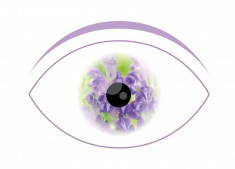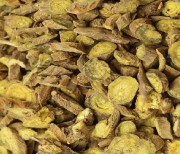PolyU research finds baicalein a promising glaucoma treatment
Other Articles
Glaucoma, an eye condition that can lead to loss of vision, is prevalent among older adults worldwide, affecting a population of 64.3 million in 2013, which is estimated to increase to 111.8 million in 2040. The eye disease has become a pronounced public health concern in an ageing global population.
Research shows that the risk for glaucoma increases with high eye pressure. Despite the lack of cure for glaucoma, lowering the intraocular pressure (IOP) in the early stage can often stop the damage and protect the vision. However, current interventions and medications that slow down glaucomatous vision loss are associated with undesirable side effects and drug resistance. Consequently, patients are less motivated to follow the doctor’s advice and the treatment outcomes are jeopardised.

What causes glaucoma?
Glaucoma is a progressive damage of the optic nerve connecting the eye to the brain. It is usually caused by fluid building up in the front part of the eye, increasing pressure inside the eye. Though glaucoma is characterised by the loss of peripheral vision, it usually has no warning signs ―― the change in vision is so gradual that one can hardly notice it until the later stages.

Baicalein
A PolyU research team is exploring a more effective treatment, having used mouse models to test whether baicalein can produce detectable changes in elevated IOP. Baicalein, a flavonoid found in the roots of a Chinese herb called Scutellaria Baicalensis Georgi, is used in treating cancers, inflammation and cardiovascular diseases, and has been identified as a potential therapeutic agent for eye diseases.
Lowering eye pressure by applying baicalein
The team comprises (top photo, from left) members from the Research Centre for Chinese Medicine Innovation (RCMI) including Professor To Chi-ho, former Director of the Research Centre for SHARP Vision (RCSV) and former Head of the School of Optometry (SO); Professor Henry Chan, Professor of SO; Dr Thomas Lam and Dr Do Chi-wai, Associate Professors of SO as well as a member from RCSV Dr Samantha Shan, Research Assistant Professor of SO.
In their study, the team applied baicalein to living mouse eyes to explore whether it affects the outflow facility, i.e. the hydraulic system that allows aqueous humour, the liquid occupying the front part of the eye, to exit the eye consistently and yet maintaining an IOP balance.
The results showed that baicalein improved the outflow of aqueous humour, thus lowering the IOP, with the maximum effect occurring three hours after the baicalein treatment. Furthermore, the IOP reduction could last for more than 24 hours. The findings indicate that baicalein is a promising treatment for glaucoma.
Established in 2021, RCMI is committed to fostering interdisciplinary and translational research for developing novel drugs, new treatment protocols and programmes based on traditional Chinese medicine practices for application in the clinical setting or community.






